The Uí Cléirigh origins
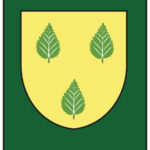 Early Irish genealogical manuscripts (including the UíCléirigh Book of Genealogy) gave an elaborate construct that placed all of the tribes of Ireland as being descended from one common ancestor Míl who crossed the sea from the Iberian Peninsula (modern day Spain and Portugal) bringing with him his sons Éireamhón, Éibhir and Ír and his nephew Íth son of Lughaidh.
Early Irish genealogical manuscripts (including the UíCléirigh Book of Genealogy) gave an elaborate construct that placed all of the tribes of Ireland as being descended from one common ancestor Míl who crossed the sea from the Iberian Peninsula (modern day Spain and Portugal) bringing with him his sons Éireamhón, Éibhir and Ír and his nephew Íth son of Lughaidh.
Modern historians understand that this construct was developed in the early Middle Ages at the behest of the Ua Néill High Kings of Ireland, in an attempt by the Ua Néill to give all the various tribes of the island a common ancestor, Míl and by placing the Uí Néill in the primary position, as being descended from Míl’s eldest son Éireamhón.
The Ua Néill claimed descent from Niall Naoigiallach (Niall of the Nine Hostages) from Connacht who invaded and conquered western part of Ulaidh(Ulster) in the 4th Century driving the Ulaidh tribes eastwards.
Niall had two other brothers Fiachra whom the Hy Fiacrach were descended from and Bríon whom the Uí Bríúin were descended from the latter tribe would later divide into such well known clans as the Uí Ruairc (O’Rourkes), Uí Conchobhair(O’ Uí Connors), Uí Raghaillaigh (O’Reillys).
The Hy Fiacrach in turn settled in two areas of Connacht, one group settled in south Connacht becoming known as the Uí Fiacrach Aidhne, the other group settled in north Connacht becoming known as the Uí Fiachrach Muaidhe living in the vicinity of the River Moy.
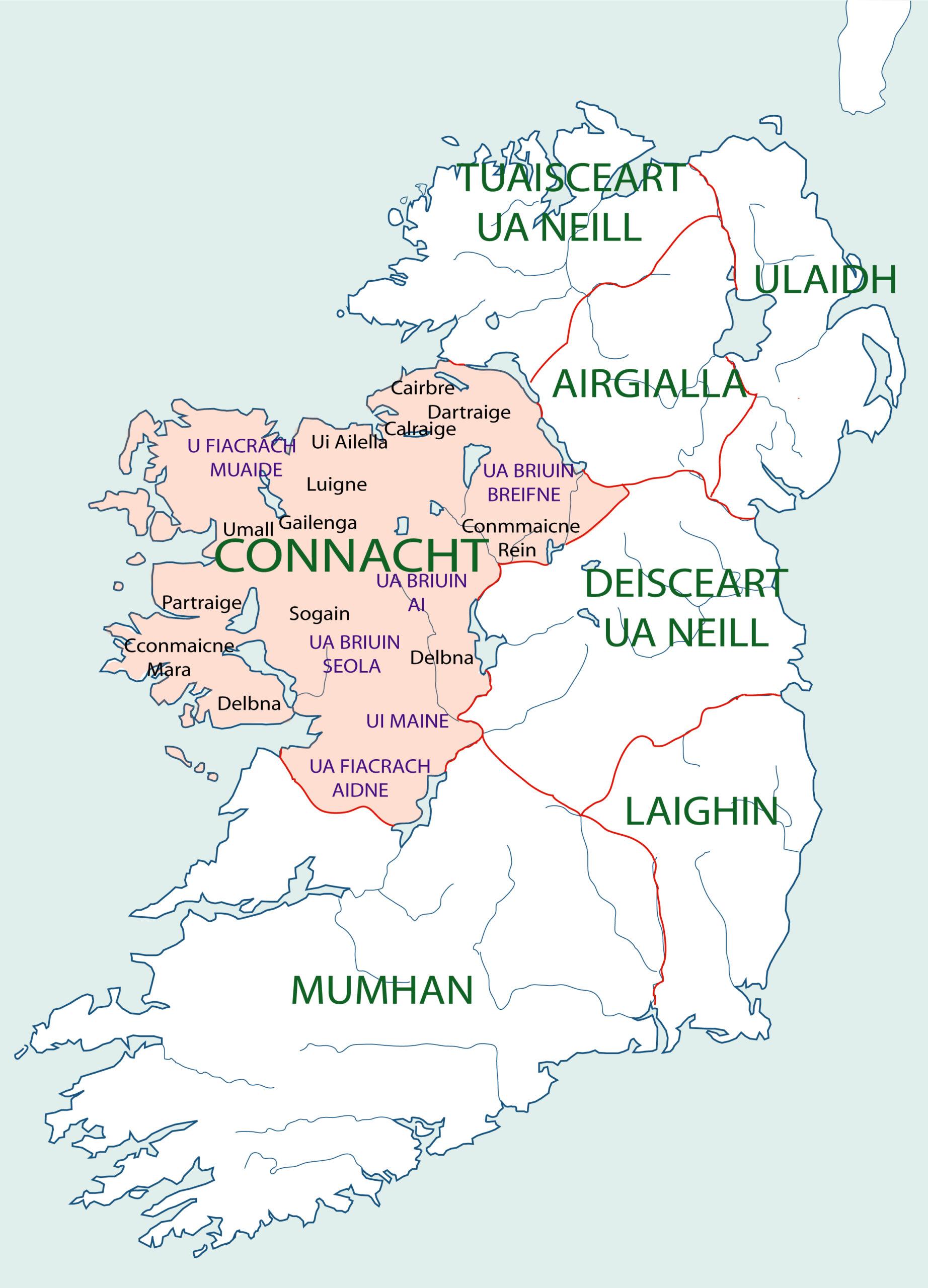
In 622 Guaire Aidne mac Colmáin became king of Connacht. A member of the Ui Fiachrach Aidhne and son of king Colmán mac Cobthaig, Guaire ruled at the height of Ui Fiachrach Aidne power in south Connacht centred on the royal site of Dún Guaire on the coast near Kinvarra in Co Galway.
King Guaire the Hospitable
In 622 AD Guire MacColmáin, of the Uí Fiacrach Aidne, became King of Connacht succeeding his father Colmáin Mac Cobtaig. In Ireland surnames were adopted much later, in the 10th Century as tribal groups expanded in numbers. Before that a son would distinguish his name by adding his father’s and sometimes his grandfather’s to his own name – (so Guaire was the son of Colmáin who was the son of Cobtaig) Guaire began his reign by attempting to push back the growing power of the Deisi Mumhan who were expanding their power into what would later become Thomond (Co Clare).
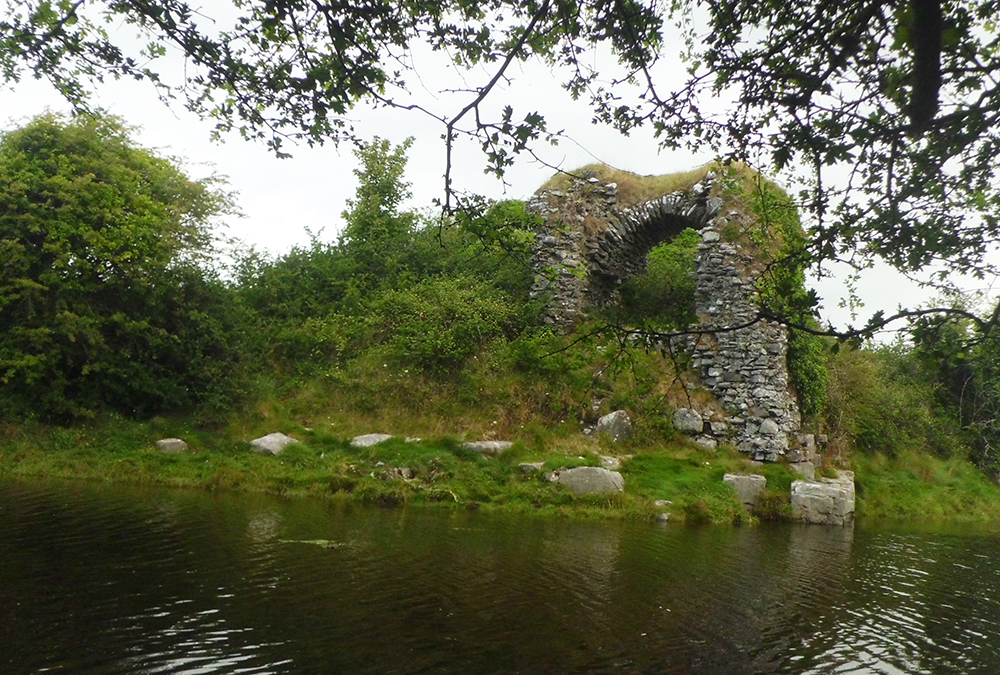
In 629 Guaire along with his ally from the Uí Maine tribe, Conall mac Máele Dúibs fought the Battle of Carn Feradaig (Carhernarry, County Limerick.) where they suffered a defeat at the hands of the Mumhan (Munster) king Faílbe Flann mac Áedo Duib. This battle effectively ended the predominance of Connacht in Thomond which became part of the kingdom of Mumhan. Things continued to go badly for Guaire and he was defeated at the Battle of Carn Conaill (in his home territory near Gort) in 649.(This was fought in the townland of Ballyconnely in the parish of Kilbecanty) In this battle he was put to flight by the high-king Diarmait mac Áedo Sláine of Brega.
Whilst not being successful on the battlefield, he earned the name of being “hospitable” of his habit of never refusing the poor help and the legend grew that when a poor person prayed at his grave, a skeletal hand would rise from the grave offering a gold coin!! He gifted his cousin Colmáin mac Duagh land to build the monastery of Kilmacduagh, later centre of the Diocese of Kilmacduagh whose boundaries would be co-extensile to that of the Kingdom of Ui Fiacrach Aidhne.
Guaire died in 662 and was buried at Clonmacnoise on the River Shannon. The Annals of the Four Masters record this event as
‘Aois Chriost sé chéd sescat a dó —- Guaire (i. Aidhne) mac Colmain rí Connacht déce’
‘Age of Christ six hundred and sixty two (662) Guaire son of Colmain, king of Connacht died’.
In an interesting footnote in the annals, it adds that Guaire and Caimin of Inish Cealtra on Lough Derg (St. Caimin,) had the same mother called “Cummain daughter of Dallbronach was the mother of Caimin and Guaire. Seven and seventy were borne of her!!
Kilmacduagh
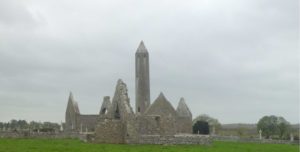
A book written in 1893 called the “History and Antiquities of the Diocese of Kilmacduagh” by Monsignor Jerome Fahy gives a very detailed account of the history of the diocese. (It can be read at:
https://archive.org/stream/historyandantiq00fahegoog#page/n162/mode/2up)
He in turn relies heavily on the book written by Dr John O’Donovan in the 1850s called the “Tribes and customs of the Hy Fiacrach” He in turn relies on much of the information contained in the “Annala Ríochta na hÉirinn” a manuscript he transcribed into English and Irish, compiled and written by the Four Masters including three descendants of King Guaire; Br Mícheál Uí Cléirigh, Cúcoigcríche Uí Cléirigh and Conaire Uí Cléirigh as well as Cúcoigcríche Uí Duibhgeannáin and Fearfeasa Uí Maoilconaire.
King Guaire of Connacht died in 662 and was succeeded firstly by Nar who was the progenitor of the Uí Moghans, John O’Donovan believed that this name was later rendered as Mooney.His second son was Arthgal, progenitor of the Uí Cléirighs, Uí h-Eidhin (O’Heynes) and Mac Giolla Cheallaigh (Kilkellys) His son Fearghal in turn succeeded to the crown of Connacht, though after his death in 694 the provincial sceptre passed from the tribes of the Hy Fiacrach to the Hy Bríon ancestors of the Uí Conchobhairs (O’Conors) who would rule Connacht up until the coming of the Normans in the 12th Century.
Cléireach was the great grandson of Commascach who was the great grandson of King Fearghal was the first to bear the name Cléireach and his descendants would retain the position of Lords of Aidhne until the 11th Century. The name Cléireach was most likely derived from the Latin Clericus meaning a scribe.
The Annála Ríochta na hÉirinn (Annals of the Kingdom of Ireland) record that
Aois Criost Naoi Céd a Sé Dég……….. Tighearnach Ua Cléirigh Tighearna Aidhne déc
(Age of Christ Nine Hundred and sixteen …………. Tighearnach Ua Cléirigh, Lord of Aidhne died………..)
The last of the Uí Cléirighs to rule Aidhne was Cugeola Ua Cléirigh grandson of Giolla Ceallaigh Ua Cléirigh who ruled Hy Fiacrach Aidhne up until 1025. He was the last of the clan to receive allegiance from the Hy Fiacrach, the Lordship passing on to the Uí h-Eidhin (O’Heynes) clan.
The Kingship passes to the Uí h-Eidhin
In 1025 Maelfaiibhail Uí h-Eidhin succeeded to the Lordship of Hy Fiacrach Aidhne. The Uí h-Eidhin (O’Heynes) clan were descended from Cléireach’s second son Eidhin.
The Uí Cléirighs continued to be subordinate chieftains in their ancestral territories in the north eastern part of Kilmacduagh up until the 13th Century.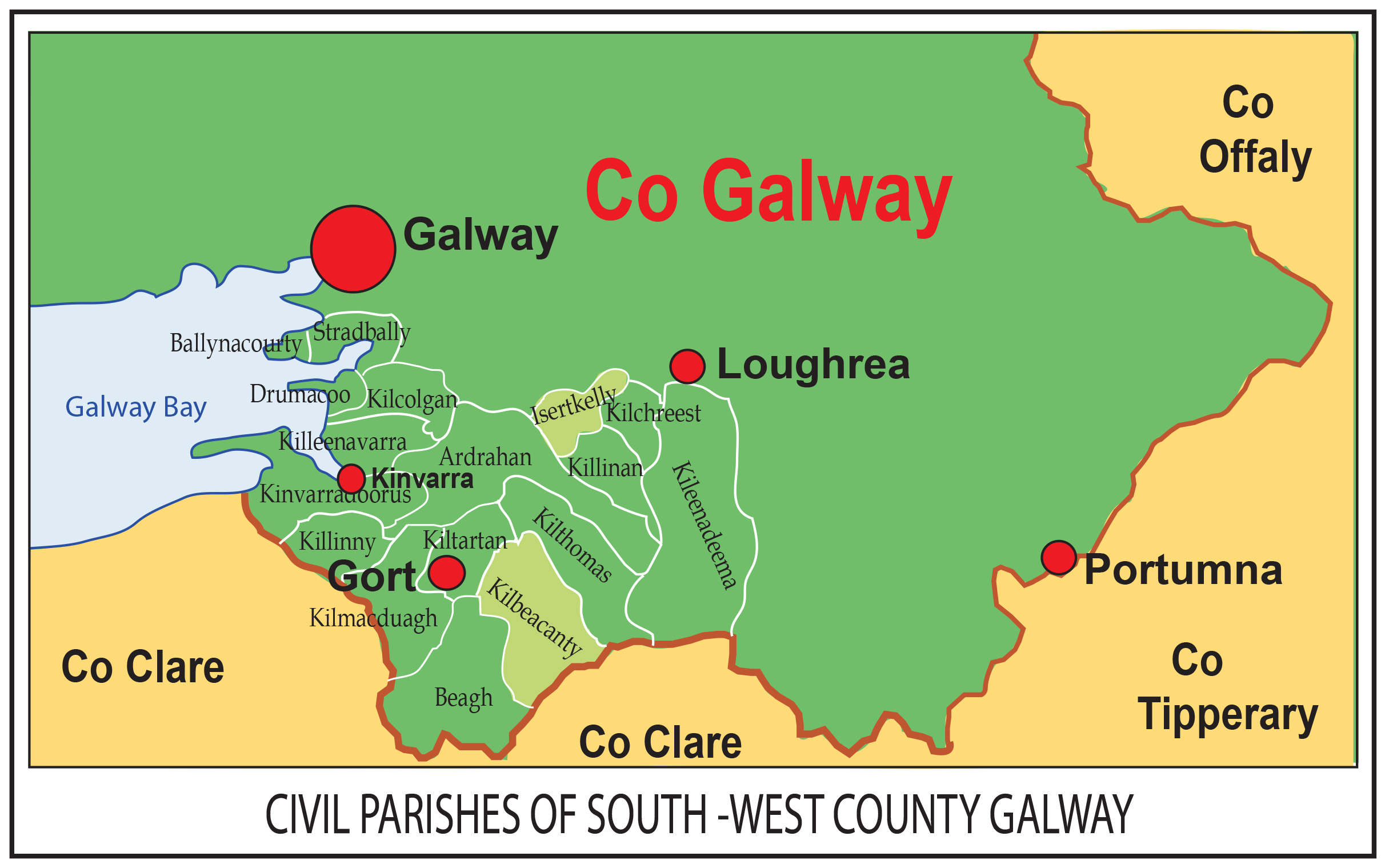
The exact location of these lands is not known for certain but it is likely that it was the lands appropriated by the two youngest sons of Walter FitzAdelm De Burgo, Hubert de Burgo at Iserkelly and Redmond De Burgo took the Uí Cléirigh lands in the parish of Kilbecanty, the townlands of Ballycahalan, Kilbecanty, Ballyconnel and Ballylibrayne known later as “Oireaght Redmond”.
In 1264 the castle of Ardrahan the chief residence of the Uí h-Eidhin was taken by Walter De Burgo, the Earl of Ulster. This event effectively ended their lordship of Aidhne and with the Norman conquest of south Connacht, the Uí h-Eidhin (O’Heynes) territory became confined to the inland part of the Barony of Kiltartan.
The expulsion of the Uí Cléirighs would probably have happened soon after the Norman capture of Ardrahan.
The ‘Uí Cléirigh book of Genealogy’ written by Cúcoigcríche Uí Cléirigh in the mid seventeenth Century tells that one Domhnal Uí Cléirigh seventh by descent from Eoghan who died in 1063 was forced from his ancestral lands and who had four sons. John Sciamhnach “the Comely” had a son Cormac who travelled to Assaroe in Tír Connaill and was the ancestor of the Uí Cléirighs of Kilbarron. The second son Donal was the ancestor of the Uí Cléirighs of Tirawley in Mayo.The third son Thomas was the ancestor of the Uí Cléirighs of Breffni. The fourth son Cormac was the ancestor of the Uí Cléirighs of Ossory or Kilkenny.
The expulsion of the Uí Cléirigh from their Kiltartan lands was extensive and its effects are found in the Downs survey of Co Galway of 1652 where none are recorded as landholders and in Griffith’s valuation in the 1850s none of the Uí Cléirigh name are recorded in the Barony of Kiltartan. However their kinsmen the Uí h-Eidhin (O’Heynes) and Uí Seachnasaigh (O’Shaughnessy) remained as titleholders up until the Cromwellian confiscations in the 1650s.
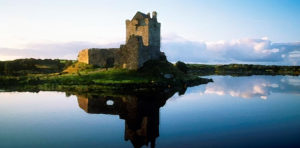
Griffith’s Valuation 1856
Griffith’ s Valuation was undertaken in the years from 1849 to 1862 and his team undertook the valuations in different counties over the thirteen year period. They surveyed County Galway in 1856. This was seven years after the Great Famine (An Gorta Mór) and though that awful event took a terrible toll amongst the poorest and began a great movement of people by force or desperation from the rural areas to the nearby towns and cities and for many ultimately to emigration, the family or clan ties to particular areas remained pretty much as it had been since the late middle ages. However it is important to remember that this valuation was not a census and does not record non-ratepayers and only records head of households and can record the same person more than once depending on where their property is located.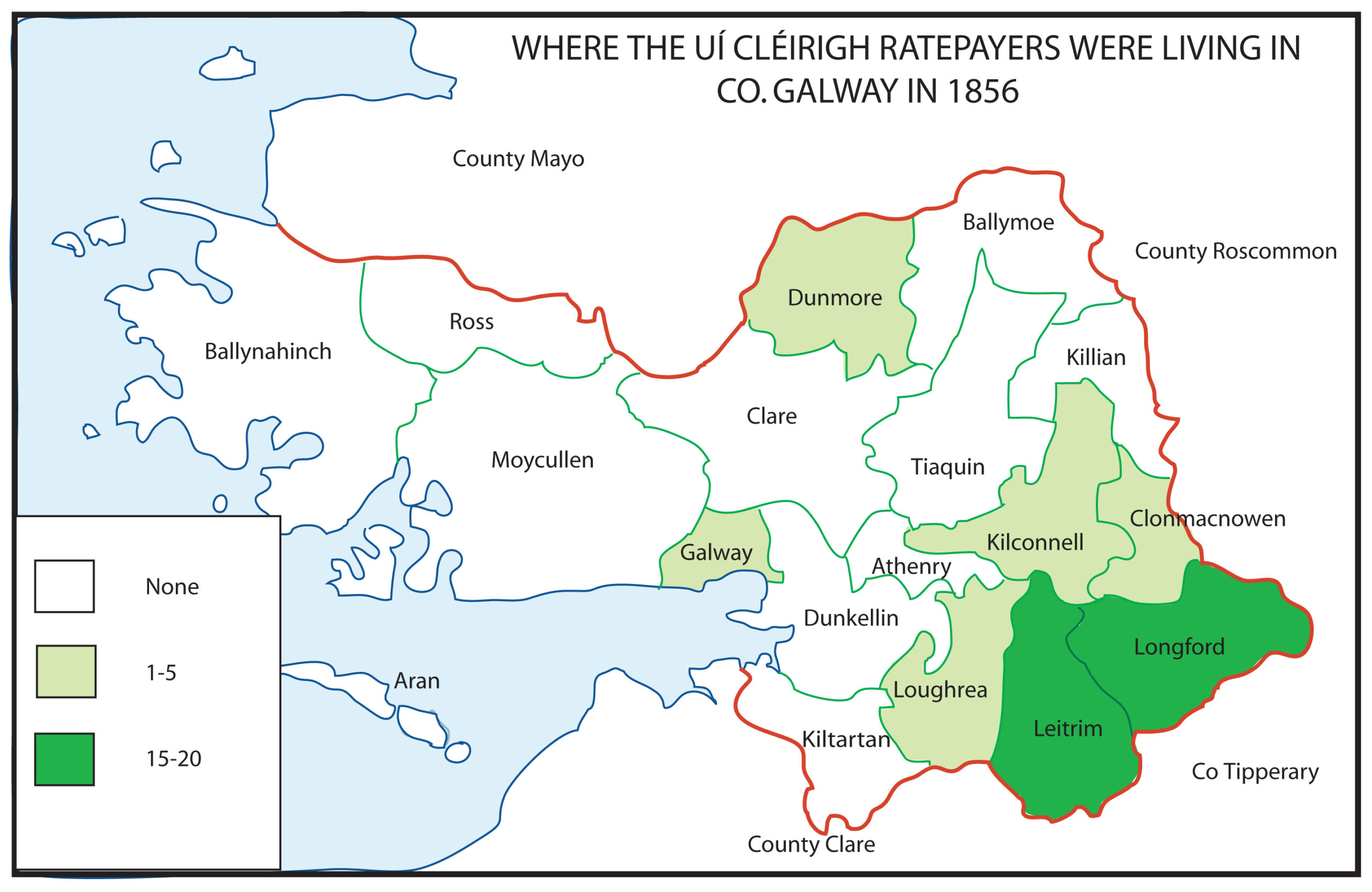
Whilst no Uí Cléirighs are found in the Barony of Kiltartan in Griffith’s Valuation, which confirms the historical information that they were expelled from these lands, a significant number are found in the nearby Baronies of Leitrim and Longford in the eastern part of south County Galway. The Baronial land divisions have been for over a century an obsolete form of administration but its roots lay in the Norman and Gaelic territorial control in the 16th Century and here we find that the Barony of Longford was the territory of the O’Madden’s whilst the Barony of Leitrim was in the control of the Norman Earls of Clanricard’s who were the overlords of all the De Burgos (Burkes). The ancestors of these Uí Cléirighs would have taken refuge and became tenants to these ruling clans. This movement eastwards may also explain the predominance of Uí Cléirighs in the counties in the periphery of County Galway that can be found to this day.
Page 2 St Colman mac Duagh
